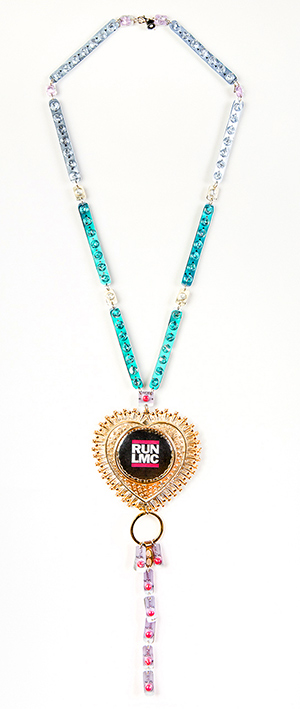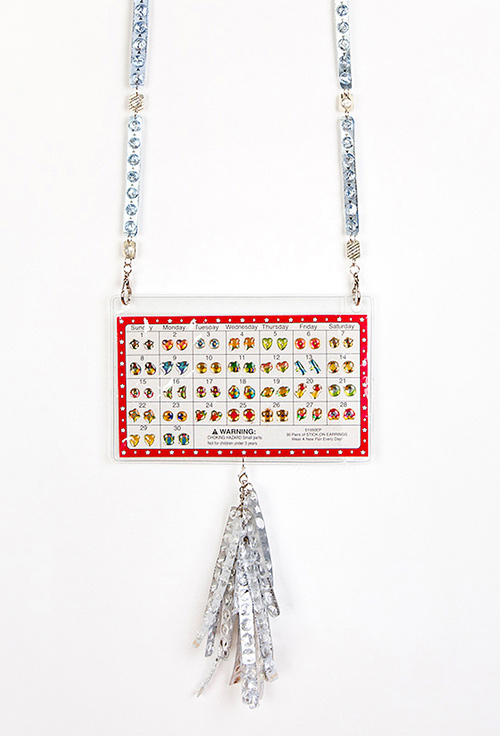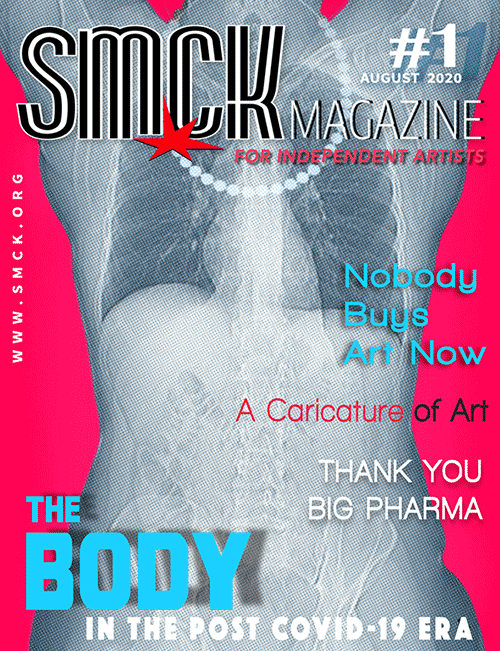UNDERFUNDED, UNDERAPPRECIATED, NOT WIDELY UNDERSTOOD. SURVIVAL IS NOT EASY
JEWELLERY ART IN AUSTRALIA
LAILA MARIE COSTA (AKA RUN LMC), ARTIST, CURATOR AND CO-DIRECTOR OF TEMPCONTEMP GALLERY ON EMANCIPATION, INDIE PERSEVERANCE AND THE SCHMUCK
Interview by Loukia Richards
 Thank You Big Pharma Series. Photo: Bryony Jackson
Thank You Big Pharma Series. Photo: Bryony Jackson
LR: In Thank You Big Pharma! - selected for Schmuck Sonderschau 2019 - you used contraceptive pill packages as jewellery material. How did Big Pharma change the female body and destiny?
LMC: The contraceptive pill gave women the freedom to manage their menstrual cycles, control family planning, prevent unwanted pregnancy. It did, in essence, provide the idea of emancipation. However, the pill, and the hormones it contains, can mess with some bodies, causing side effects. Why has the responsibility of contraception conveniently fallen into the hands of women, and men are excused?
LR: Why is menopause (still) a taboo even among women?

Thank You Big Pharma. Photo: Bryony Jackson
LMC: Peri/menopause and/or The Change is not very sexy and rarely spoken about. Hormone Replacement Therapy (HRT) is big money, and from the point of view of drug companies allows women to seamlessly move from one product - birth control - to the other. Menopause is such a mysterious issue, both in society and the medical field. In my world, people really don't want to discuss it. On the up side, the packaging of HRT is a source of inspiration.
LR: What kind of social status and background does your jewellery reflect?
LMC: My jewellery is autobiographical narratives about my existence in a suburban environment and my nature/nurture. The body ornaments I create reflect my status as working class, post-graduate educated, low income earner, first generation Italo/Australian, cis, Caucasian, child free, female divorcee, with mental-health issues, and neuro atypical with a wry sense of humour.
The value of the jewellery is not monetary, but intellectual, and it's at times elitist about cultural capital. It is imbued with political and social concepts; with references to the history of art, design, and craft; and explores themes that relate to my navigation of life.
SCHMUCK LESSONS
LR: How did you benefit from your participation in Schmuck Sonderschau 2019?
LMC: The mental confidence it gave me is invaluable. It confirmed I'm doing something valid that is part of the contemporary conversation. I thank the curator, Dr. Sabine Runde, for taking a risk with an outsider.
I went to Munich for Schmuck and spent seven days experiencing exhibitions, meeting with artists I admire, chatting with curators and educators. It was also beneficial for TempContemp, as people I met gained knowledge of it and the concurrent Schmuck / Schmock exhibition. I also met artists who had applied to participate in TempContemp group exhibitions.
Being a visitor at a European jewellery festival inspired and informed my practice as a curator and gallerist. The most direct outcome was that my work was selected for inclusion in the Body Control exhibition at Museum Arnhem, the Netherlands.
LR: How did you like Schmuck?
LMC: I found Schmuck München too large and it was impossible to get to see all the things I'd wanted to. Either the timeline needs to be increased or the number of exhibitions decreased, which would be my preference.
The actual Schmuck Sonderschau, in the Messe, was quite a conservative affair though I was expecting nothing less. The Talente exhibition I found quite compelling.
INDIE GALLERIES' CHALLENGES AND FUNDING SCHEMES
LR: What problems and challenges do you face as an indie gallerist in Australia?
LMC: In Melbourne, there's an indie scene that runs alongside the commercial galleries. The Big Four—Gallery Funaki, Studio Ingot, e.g.etal, and Pieces of Eight—focus on retail sales and commissions. They all have an exhibition program by artists they represent. Occasionally non represented artists are included in group exhibitions, most notably the Mari Funaki Award for Contemporary Jewellery, which attracts the rock stars. There are some public galleries, museums, and organisations that have the odd contemporary jewellery show.

Thank You Big Pharma. Photo: Bryony Jackson
There is the fabulous Radiant Pavilion, the Jewellery and Object Biennial, which is attracting global applications. TempContemp is different. We explore jewellery as an interdisciplinary practice, as a place of experimentation, trying new concepts and ideas without the pressure of having to make sales.
Melbourne is the jewellery galleries hotspot. Survival isn't easy for any of the various components of the system. Like most arts communities, jewellery is underfunded, underappreciated, and not widely understood. If you manage to secure stable work in the sector, it's poorly paid and overworked in comparison. Exploitation occurs.
There is no established centuries-old integration of the arts and knowledge of history in everyday life. That can also be an advantage. Grants are the usual way to get funds for a project. We secured two Arts Investment grants from the local council, Moreland. Sometimes the pay-to-play model is the only way to survive. It's a system fraught with ethical and moral considerations.
Without the volunteers we wouldn't exist. Some of our fab volunteers: Claire Vaganiance, Peregrine Costa, Jessica Phippen, Aphra Cheesman, Fiona Fitzgerald, the Insecurity Guards and many others.
LR: What kind of artists did you present in TempContemp Gallery?
LMC: In our time at Northcity4, our previous brick-and-mortar address, we produced group exhibitions: I Hate Contemporary Jewellery, Do You Copy?, Schmuck/Schmock, and Radical Pavlova; a one-night event.
I curated The Urban Gleaner and the Plastique Pt.II. for the Climarte festival. We also put on one pay-to-play model exhibition, In Dialogue, for Radiant Pavilion 2019. Our final exhibition, O, was a group exhibition by some of our incredible volunteers.
The various artists came from all around the world. We did take a 20 percent commission on sales and have acquired some works exhibited in these shows for the TempContemp Collection. We selected pieces that we found compelling, whether we personally liked them or not. I enjoy this way of curating, as you have to relinquish control and have faith in the respondents.

The team. Photo: Leila M. Costa
LR: How do you choose the artists you represent?
LMC: Working to optimize the artists' work takes effort that an artist-run initiative cannot afford. While Studio Ingot represents me, our arrangement is very workable; it relies on give and take from both parties and aligns with my current needs. The traditional model of signing an artist is one I'm not so comfortable about. I'm more an indie, DIY type. Both systems have their benefits. It depends on how the artist wants to place themselves and their career.
We don't formally represent anyone at the moment. To represent artists is a large commitment and one we would not take lightly. We don't have the resources for it in the short term.
LR: How do you imagine future shows given that COVID-19 will persist for at least a few more months?
LMC: More online virtual exhibitions and projects as galleries begin to reopen. Snail mail sounds promising. Collaborations. Interventions. Live streaming. Zoom fests. I want things to happen that I never even thought possible. I want the industry to be moved by this happening.
LR: Your plans for the future?
LMC: In October I'll have a solo exhibition at Bridget Kennedy Project Space, in Sydney. I don't want to be too precious; I want to allow space for works that are unplanned and unstructured. After isolation restrictions lift, I'll return to my studio and recommence my artist residency at the East Brunswick Village.
LINKS: www.tempcontemp.com/
www.lailamariecosta.com/








